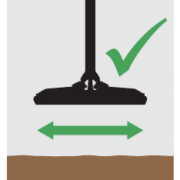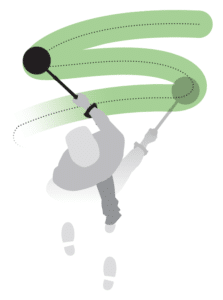Achieving good ground balance is imperative to successful gold prospecting; without it, false signals from mineralised ground can mask gold signals. While most gold prospectors are familiar with the ground balance process used with PI detectors, such as the GPX Series, the new technology of the GPZ 7000 requires a new technique. This article describes advanced ground balancing methods for obtaining optimum performance and gives tips for maximum detecting success.
How NOT to ground balance the GPZ 7000
Using the GPX Series ground balance method for PI technology

It is important to realise that the ground balancing operation of the GPZ 7000 is different to PI metal detectors.
The GPZ 7000 uses new ZVT technology that analyses many more ground parameters and needs to be physically ground balanced by moving the coil in a different way.
Why is the GPZ 7000 different?
What happens with ZVT technology when ground balancing After the GPZ 7000 is switched on, and the Quick‑Trak trigger is pressed, the detector calibrates itself to the local ground conditions within several seconds of moving the coil over the ground. This initial fast calibration involves several different aspects of the detector being calibrated, not just the single parameter as described above.
Upon further searching, the ground balance continually tracks or ‘updates’ the primary soil ground balance data moderately quickly, but the additional parameters calibrated during the initial ground balancing are far more slowly updated. These extra measurements also contribute to how well the GPZ 7000 is ground balanced and 'tracks' to the changing ground conditions as you detect.
To ground balance well, the GPZ 7000 requires as much DIFFERENT data about the local ground conditions as possible, especially variations in the soil mineralisation.
Therefore, ground balancing using the typical PI method of raising and lowering the coil over only one spot of ground is the worst way to ground balance the GPZ 7000. This is because this method merely provides the detector with data from just one small area of the soil, and not data from a larger area and wider variety of soil mineralisation.
How to ground balance the GPZ 7000
Using the GPZ 7000 ground balance method for ZVT technology
 The best way to ground balance initially after switch on, is to press and hold the Quick‑Trak trigger while sweeping the coil in a typical side‑to‑side search motion at the recommended coil operating height above the soil surface, e.g. 2–3 centimetres or whatever the soil saturation or terrain will allow*. At the same time, move forward at a slightly faster than normal walking speed, so as to cover as much different ground as possible in the first 10–12 seconds.
The best way to ground balance initially after switch on, is to press and hold the Quick‑Trak trigger while sweeping the coil in a typical side‑to‑side search motion at the recommended coil operating height above the soil surface, e.g. 2–3 centimetres or whatever the soil saturation or terrain will allow*. At the same time, move forward at a slightly faster than normal walking speed, so as to cover as much different ground as possible in the first 10–12 seconds. 
Cover as much different ground as possible when performing initial ground balance, trying not to overlap your sweep.
* Refer to KBA 24 'ZVT Technology' for further information and tips on ground balancing in saturable soil conditions.
At completion, the Quick‑Trak trigger should be released and the detector is ready for searching using normal detecting methods.
You can then easily check how well the detector is ground balanced to the exact location by using the conventional method of raising and lowering the coil over one spot to ensure the detector is quiet.
Note– you must NOT perform this ground balancing coil up‑down checking method after initially turning on the detector, but only after searching for at least several minutes.
Even though the ZVT signal processing continually updates the ground balance settings during searching, occasionally, the soil conditions may change abruptly and the detector will need re-ground balancing (by pressing and holding the Quick‑Trak trigger and using the above sweeping technique).
Correcting poor initial ground balance
If you happen to initially ground balance in an abnormal location (e.g. too close to a metal target or over an unusual patch of soil), the initial calibration may end up being inaccurate. This will cause extra audio signals when detecting. This is because the slowly updating calibration is taking a longer time to become more accurate to the typical conditions (rather than the initial abnormal conditions).
Thus if you think the detector is producing an unexpected level of soil signals, switch the detector off, then on again, and re‑ground balance. Usually, this time, your detector will be correctly calibrated from the restart.
 If your detector is still producing an unexpected level of soil signals, select Quick Start on the Detect page, and then select Reset Audio and Detector Settings when prompted by the menu. Then re-ground balance by following the Quick Start guide sequence steps.
If your detector is still producing an unexpected level of soil signals, select Quick Start on the Detect page, and then select Reset Audio and Detector Settings when prompted by the menu. Then re-ground balance by following the Quick Start guide sequence steps.
How do you know if your GPZ 7000 is correctly ground balanced?
If you have a loud audio response from the ground, pass the coil back and forth over the same spot for approximately 20 seconds. If the audio signal disappears then this likely indicates ground noise. This will be especially so if you are also pressing and holding the Quick-Trak trigger.
An advanced ground balancing method for optimum performance
In order to artificially add extra data for improved ground balance calibration, you can use a dust iron toroid, commonly referred to as an electronics 'ferrite'. The electronics industry uses these magnetic cores extensively in computers, televisions, and mobile phones.
Ground balancing using a ferrite means that less soil needs to be covered during the initial ground balance period because the ferrite artificially adds very useful data to assist achieving an accurate ground balance.
The easiest way to add this data during the initial ground balance, and and ideally, at all later ground balancings, is to place the ferrite on the soil surface and swing the coil over it several times in wide sweeps at the operating height of the coil, whilst ground balancing, so as to include data from both the soil and the ferrite.
 Ground balancing with a ferrite: The sweep path crosses over the ferrite numerous times whilst also covering as much different ground as possible.
Ground balancing with a ferrite: The sweep path crosses over the ferrite numerous times whilst also covering as much different ground as possible.
![]() Make sure that you pass the coil over the ferrite almost immediately when you start the ground balancing procedure.
Make sure that you pass the coil over the ferrite almost immediately when you start the ground balancing procedure.
If the GPZ 7000 produces more than a faint audio ‘murmur’ when the coil is swept over the ferrite, at a height of a centimetre or two, then it is NOT correctly ground balanced. If it does produce a significant audio signal, re‑ground balance using the ferrite as above. If it then still produces a significant audio signal from the ferrite, switch the detector off, then on again, and re‑ground balance using the ferrite as described above.
Ground Balance with the Ferrite
- Find an open area free from targets and place the ferrite on the soil surface.
- Turn GPZ 7000 ON.
- Select Quick Start on the Detect page.
- Select Reset Audio and Detection Settings.
- Carry out Noise Cancel.
- When ground balancing, press and hold the Quick‑Trak trigger, then start to sweep the coil at normal detecting height in a figure 8 motion. IMPORTANT: Make sure that you pass the coil over the ferrite almost immediately when you start the ground balancing procedure.
- Continue to sweep the coil over as much ground as possible, for 10–12 seconds, while passing the coil over the ferrite every sweep, as shown. NOTE: Once the audio tone remains quiet and constant when the coil is swept over the ferrite, ground balance is complete.
- Release the Quick-Trak trigger button and start detecting.


































































